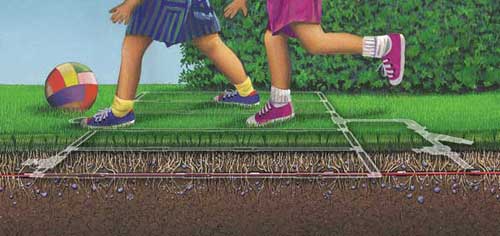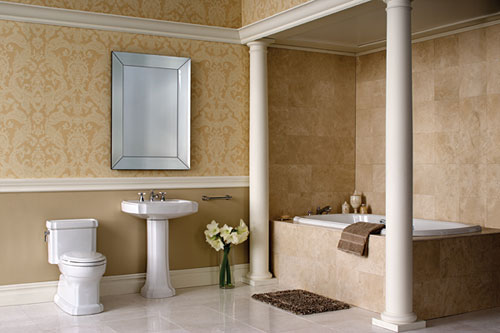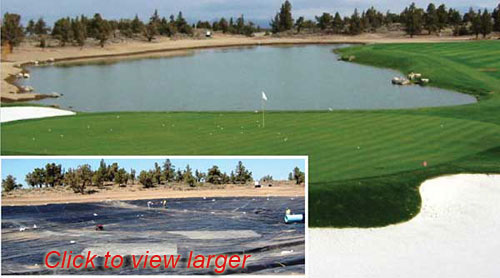Conserving Water for a Thirsty Planet
Dripline irrigation systems can achieve an 85 to 95 percent water-use efficiency compared to about 50 percent efficiency for conventional spray head systems. Some dripline systems are even designed for sub-surface installation because they provide protection against root intrusion. By irrigating underground, there is no water lost to evaporation. Design professionals who wish to reduce outdoor irrigation water use by as much as 50 percent can use high−efficiency sprinklers and dripline irrigation systems to achieve their goals.
 |
Subsurface irrigation systems are installed to reduce evaporation and can be integrated into active turf lawn areas. Image courtesy of The Toro Company |
Â
Waste water is sent to municipal treatment centers or is processed through individual or group septic systems. Some designers have experimented with building "living machines" initially developed by bioligist, Dr. John Todd. These ecological systems provide an organic purification system for buildings. At the Adam Joseph Lewis Center for Environmental Studies, watewater is sfiltered in a greenhouse and tested by students to verify that the system meets effluent standards. Examples like this are beginning to change the concept of waste water discharge in buildings.
Primarily in the West, irrigation water is drawn from municipal sewage water that is treated to an appropriate level for plants, but not necessarily for drinking water. This provides water to irrigate golf courses and recreation complexes.
Pronghorn Club Resort in Bend, Oregon |
View from the 13th hole of Pronghorn Lake after and during construction. Photos courtesy of BTL Liners, Inc. In 2003, the Pronghorn Club Resort in the city of Bend, Oregon installed a manmade lake lined with a reinforced heat welded geomembrane used to contain the cities overflow waste water. This decorative lake was designed to contain treated wastewater which was then used for irrigation on the resorts two golf courses. An alternate method of water storage and use, these environmental liners and geo tech fabrics are substitutes for concrete, steel and bentonite liners used in infiltration, storage systems and cisterns. According to Ron MacKenzie at BTL Liners, Inc., "The world is starting to get smarter in its use and re-use of water." |
Â
NEW TECHNOLOGIES FOR OLD PLUMBING FIXTURES
In 1992, the EPA launched the ENERGY STAR program to help consumers identify energy efficient equipment. WaterSense is an EPA partnership program providing education, resources and case studies of plumbing fixtures and equipment. The EPA WaterSense label means that the products have been tested and certified by an independent third- party to meet EPA criteria for water efficiency and performance.
WaterSense also is an organization that develops new standards for water efficient products. Most current standards are based on the Energy Policy Act (EPAct) of 1992 that mandated the use of new plumbing fixtures and fittings to reduce water use in buildings.
The maintenance of water equipment and the training of occupants to use water wisely is an important piece of any water system. According to the EPA, leaky faucets that drip at the rate of one drip per second can waste more than 3,000 gallons of water each year,3 leaking toilets account for even larger amounts of waste. There are many water calculators on the Internet which provide instructions as to how to choose efficient water fixtures and detect leaks to calculate and measure water use.
Gunnar Baldwin, LEED AP, Water Efficiency Specialist at TOTO USA, consults as a member of one of the U.S. Green Building Council's technical advising committees and is a director for the new organization, The Alliance for Water Efficiency.4 This organization is a voice and a platform for water efficiency which hosts a web clearinghouse on water conservation research and regulations.The Watersmart Guidebook, published by the East Bay Municipal Utility District,5 is an example of the many documents collected on this inclusive website. In the early seventies, Baldwin said that he was part of the "lunatic fringe," but today his vision of the 1.6 gallon flush toilet is now the EPA standard and he is now "swimming mid- stream with the flow."
High-Efficiency Toilets
Waste water accounts for the largest water use in homes, and engineers have focused on how to make toilets and urinals use less water.
 |
High-end bathrooms can have high-efficiency toilets, faucets and showers. Photo courtesy of TOTO USA |
Â
The first water closets, or toilets, were patented by Alexander Cummings in 1775 with an "S" trap that is still used today. The first public toilets were exhibited at the Crystal Palace in 1851. This world exhibition showcased the future and indoor plumbing was a promise quickly embraced by growing industrial nations. Low consumption toilets were already in use on trains and yachts as early as 1968. By the 1970's, the new environmental movements in Europe and the United States challenged inventors to find new means to reduce the flushing mechanism of toilets. It was not the lack of water driving this innovation, but the excess of water in the waste stream, as there had been systematic failures of septic systems, as well as municipal sewage treatment failures in large cities such as Boston. Most flush toilets used between 5 and 8 gallons of drinking water per flush before new standards were enacted.










